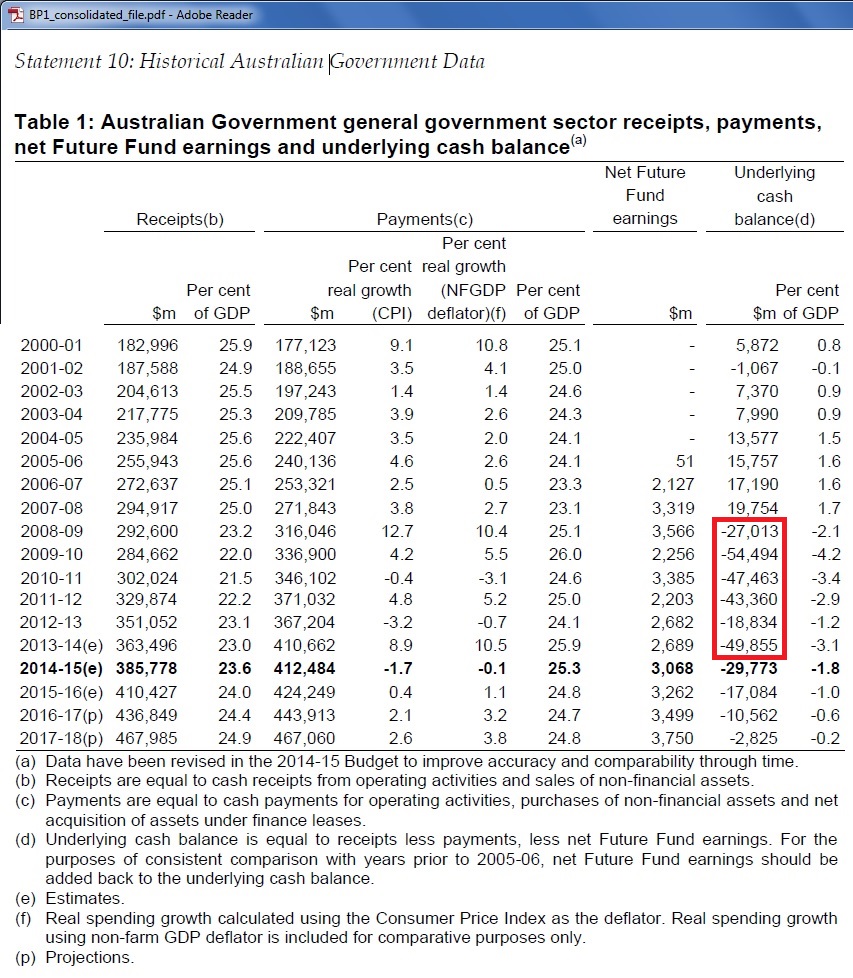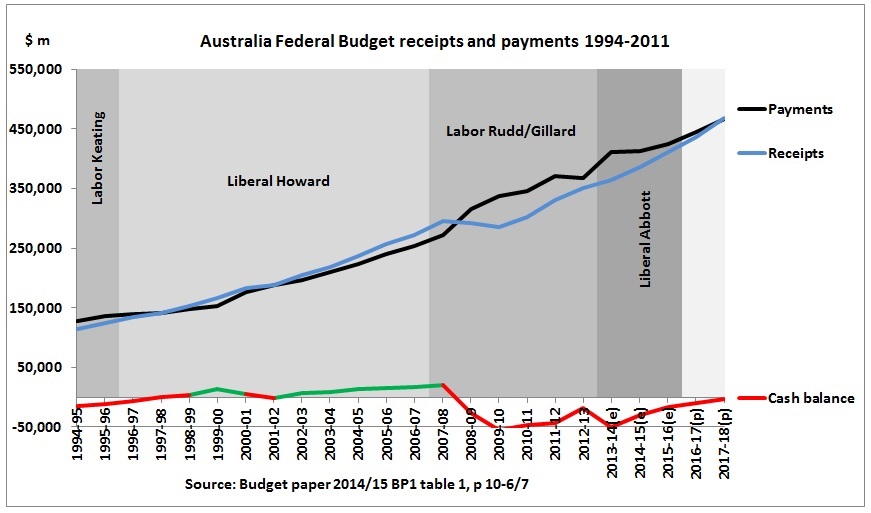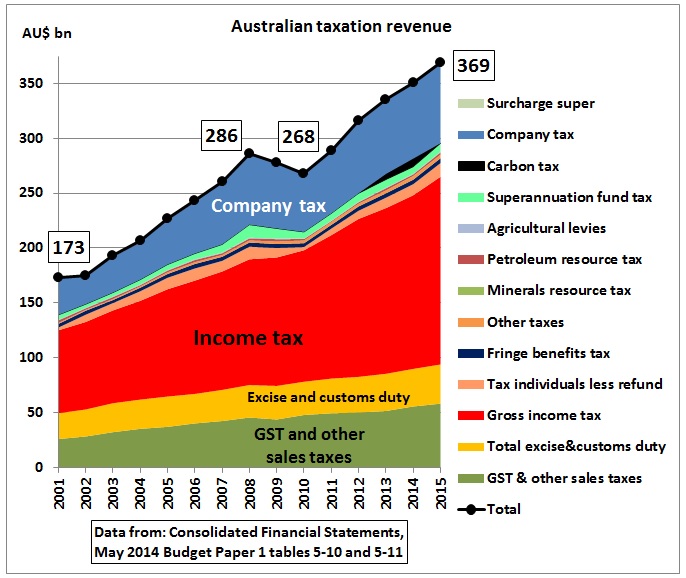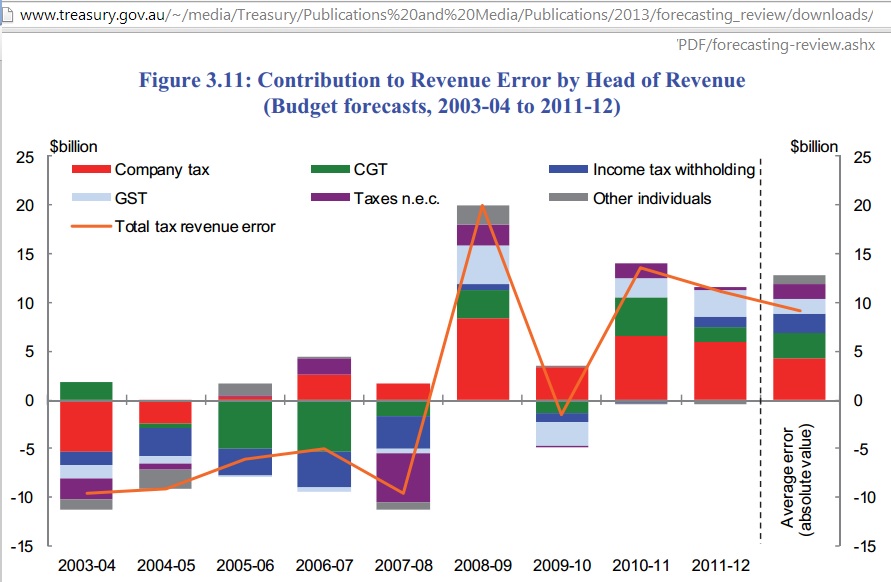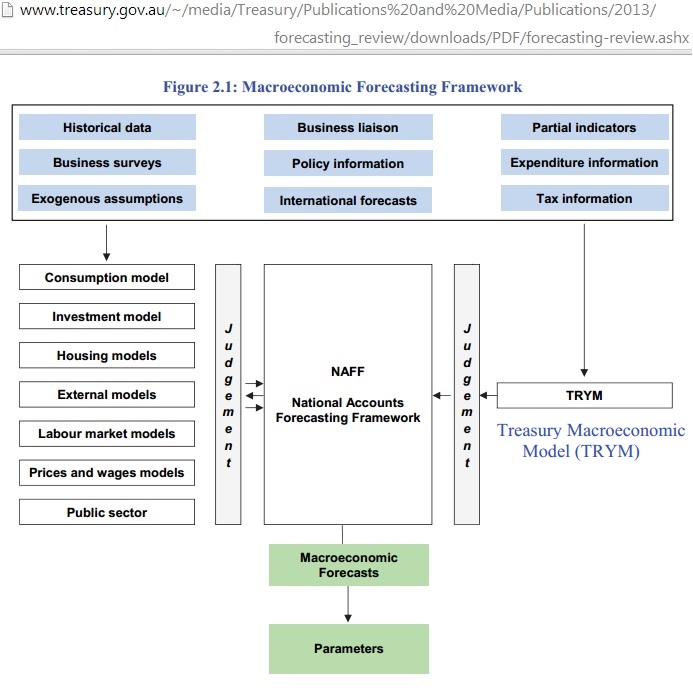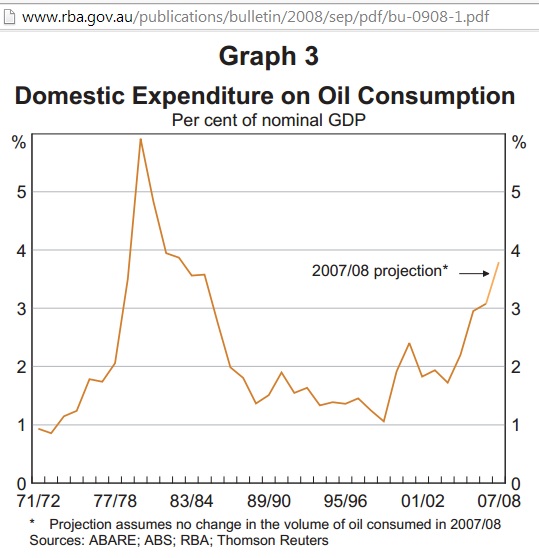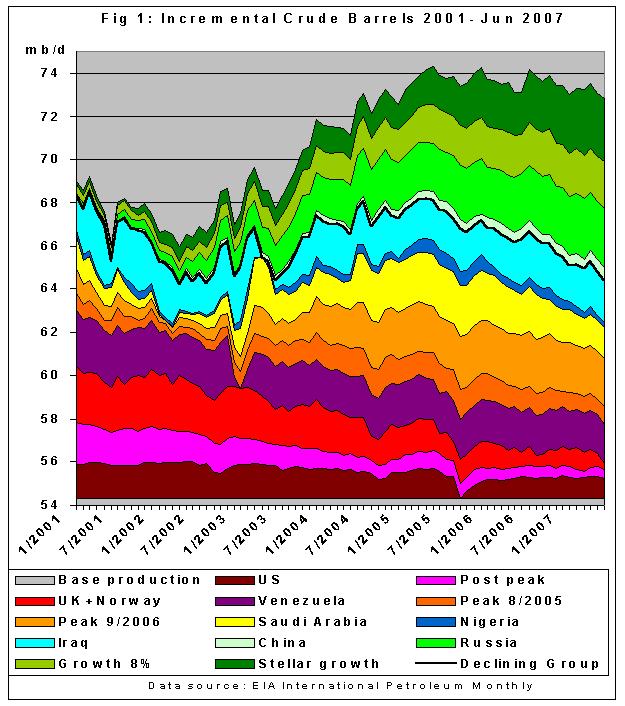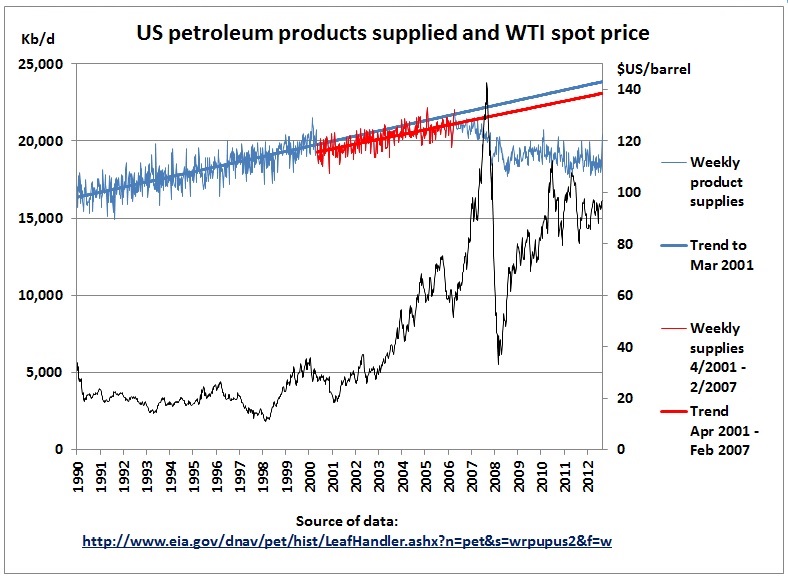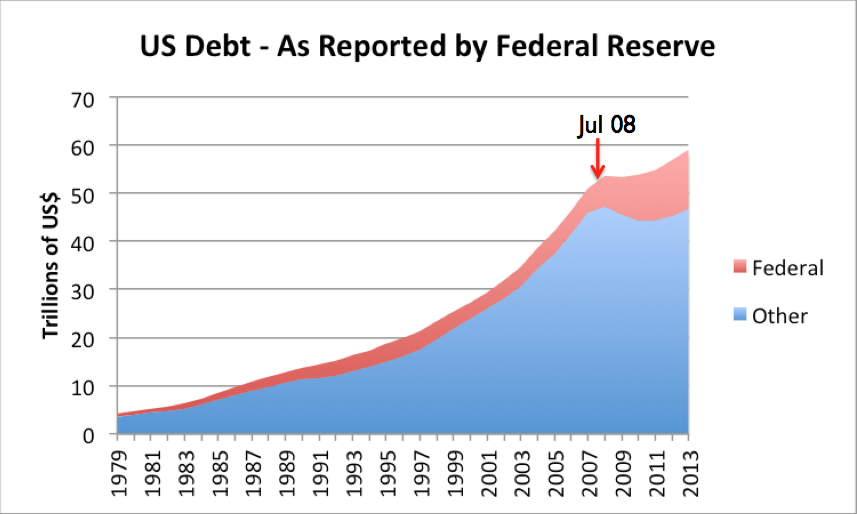The Australian Federal Government’s cumulative cash balance between 2008/09 and 2013/14 was deep in the red, at $ -241 bn. If company tax had continued to grow at pre-GFC levels this deficit could have been around 60% lower. The global financial crisis (GFC) was triggered by an oil supply shock in 2007 and an oil demand shock in 2008. The negative impact of this crisis on the economy continues with high oil prices. The government’s oil-dependent motorway program will make this situation worse. It will also increase corporate and bank debt in Private Public Partnerships. The 2014/15 budget papers contain no calculations how this debt will ever be paid back.
Fig 1: Budget 2014/15 extract from table 1, statement 10:
http://www.budget.gov.au/2012-13/content/bp1/download/bp1.pdf
Forward estimates forecast another debt of $ -60 bn for the period 2014/15 to 2017/18.
Let’s put that table into a graph:
Fig 2:Federal government’s receipts and payments timeline
Data from here: http://www.budget.gov.au/2014-15/index.htm
There are kinks in 2008 both in the receipts and payments curves as a result of the GFC (global financial crisis). Except for the year 2000 (impact of overseas recession and reduction of company tax from 36% to 34% in 2000/01 and to 30% in 2001/02) receipts increased strongly until 2007/08, at 8% pa but then declined for 2 years thereafter. In 2010/11 growth continued at 7% pa but remained below the pre-GFC trend line as shown in this graph:
Fig 3: Payments on pre-GFC receipts trend
Let’s have a look at how the receipts developed over time (including the 2014/15 budget)
Fig 4: Australian taxation revenue
There is a distinctive kink in the revenue curve in the year the GFC started. This is not unique to Australia. The same disruption appeared in the UK budget. Australia is better off as growth rates are higher.
Fig 5: Comparison taxation revenue/receipts Australia – UK
We can see in Fig. 4 that company tax receipts took a big hit. The carbon tax is negligible in the scheme of things.
Fig 6: Hypothetical company tax shortfall
Assuming that company tax after the cut to 30% had continued to grow at the 2003/08 average of
$ +6.5 bn pa (blue columns) an additional tax of around $ 150 bn could have been collected for the period 2009-2014. That would have been around 60% of the total shortfall of $ -241 bn in that period.
A Dec 2012 review of budget forecasts prepared by Treasury’s own Advisory Panel concluded:
“The Review finds that Treasury overestimated revenue growth during the GFC and Mining Boom Mark II. This reflects large forecast errors in the company tax, GST and CGT revenue heads”
Fig 7: Company tax (red columns) overestimated
“The reasons for the company tax forecast errors are a matter of concern and continue to be
investigated. They are likely to reflect in part the poor performance of the company tax forecasting model in cases where sectors of the economy are growing at very different rates, as was observed during the GFC and Mining Boom Mark II”
Other reasons for company tax below forecasts were given as:
- Gross operating surplus (GOS) of companies grew while company tax fell (deteriorating relationship between GOS and company tax)
- high depreciation deductions, relating to the huge increase in capital investment as part of the mining boom, and higher royalty expenses
The Grattan Institute came to similar conclusions in its Apr 2013 paper (chapter 5.4)
“Budget pressures on Australian Governments”
http://grattan.edu.au/static/files/assets/ff6f7fe2/187_budget_pressures_report.pdf
While the GFC is recognised as a cause for budget deficits, higher oil prices were not mentioned in the Treasury Review as a reason for lower company taxes, reflecting a lack of appreciating the role of high fuel prices in the economy.
Fig 8: Diagram from p 14 of the Treasury Review.
Quote (p 12): “The NAFF(National Accounts Forecasting Framework) unit is also accountable for the technical assumptions that underpin Treasury’s macroeconomic forecasts (for example, there are technical assumptions for interest rates, exchange rates and oil prices). These assumptions are reset at the start of each forecasting round. The usual assumption is that exchange rates and oil prices will remain around recent average levels, and that interest rates will evolve in line with market expectations. These assumptions are not always applied mechanically — for example, if the path for interest rates implied by market yields is diverging from the forecasts made by market economists, then weight may be given to both sources of information in arriving at a technical assumption. The assumptions are revisited throughout the forecasting round if there are significant movements in any of these variables.”
Let’s have a look at company profits:
Fig 9: Australian company profits before income tax
The data for the above graph are from table 9 of “Business Indicators” Cat 5676 ABS
http://www.abs.gov.au/AUSSTATS/abs@.nsf/DetailsPage/5676.0Dec%202013?OpenDocument
We can see mining booms Mk I and II and also the GFC dip in manufacturing. More importantly, profits of around 50% of the companies have peaked. Recent growth in this group has been offset by decline in manufacturing. Reduced tax revenues from closing refineries, downsizing airlines and closing of car manufacturing are not included yet.
Discussion
In Sep 2008 the RBA warned:
“Having peaked briefly at 6 per cent of GDP in 1980, spending on oil declined to less than
2 per cent of GDP in the late 1980s and remained low throughout the 1990s. Spending on oil is estimated to have since returned to around 4 per cent of GDP. While still lower than its level in the 1970s, this implies a significant reduction in real household purchasing power in recent years due to higher oil prices.”
Fig 10: Oil consumption as percent of GDP
http://www.rba.gov.au/publications/bulletin/2008/sep/pdf/bu-0908-1.pdf
In June 2009, Steve Kopits from Douglas Westwood found for the US economy:
“In every case when oil consumption breeched 4% of GDP, the US has suffered a recession, and indeed, the current US recession began within two months of oil hitting the 4% threshold, that is, when oil reached $80 / barrel.”
In the same year, the RBA publishes a paper titled
“The Economic Consequences of Oil Shocks: Differences across Countries and Time”
It distinguished oil supply shocks, oil demand shocks driven by global economic activity shocks and oil specific demand shocks. The conclusion was:
“….after an oil demand shock driven by a global economic upswing, output temporarily increases and consumer prices rise strongly. This is in contrast to an oil-specific demand shock, after which economic activity temporarily declines and inflationary effects are mostly insignificant……We find that all the net oil- and energy-importing economies (the euro area, Japan, Switzerland and the United States) experience a permanent contraction in economic activity and a significant boost in inflation, whereas the long-run output response in the oil- and energy-exporting countries (Australia, Canada, Norway and the United Kingdom) is insignificant or even positive.”
http://www.rba.gov.au/publications/confs/2009/baumeister-peersman-vanrobays.html
Alarm bells off. No mention of the GFC which was triggered by an accumulated debt crisis and high oil prices. The RBA article mentions James Hamilton’s paper
Causes and consequences of the oil shock 2007/08
“….the price run-up of 2007-08 was caused by strong demand confronting stagnating world production. …..…The experience of 2007-08 should thus be added to the list of US recessions to which oil prices appear to have made a material contribution.”
http://muse.jhu.edu/journals/brookings_papers_on_economic_activity/v2009/2009.1.hamilton.html
In fact, as the US recession took hold in the 2nd half of 2007, the world faced a supply shock as can be seen in the following graph which I published together with Gail the Actuary from Atlanta, Georgia, in the oildrum blog:
Fig 11: Incremental crude oil production by June 2007: Saudi Arabia in decline
9/10/2007 Did Katrina Hide the Real Peak in World Oil Production? and Other Oil Supply Insights http://www.theoildrum.com/node/3052
The supply shock 2005-2007 was followed by a demand shock in mid 2008 when China went on the oil market with an additional 800 kb/d for the Olympic Games. By mid 2008 crude oil production (including in Saudi Arabia) had increased again but not sufficiently.
Fig 12: Chinese oil demand in mid 2008
The ramp-up in production had to be paid by the highest oil prices ever, which triggered the GFC.
Fig 13: US oil demand peak was in 2007
http://crudeoilpeak.info/us-oil-demand-peak-was-in-2007
The heart attack of the world economy had happened as predicted by Matthew Simmons in his book “Twilight in the desert, the coming Saudi oil shock and the world economy”. US shale oil came too late. This expensive oil did not bring down oil prices anyway.
Gail the Actuary just did an interesting post titled
“The connection between oil prices, debt levels and interest rates”
Extracts:
“The economy doesn’t just grow by itself (contrary to the belief of many economists). It grows because affordable energy products allow raw materials to be transformed into finished products. Increased debt helps energy products become more affordable.”
“The availability of increased cheap debt tends to pull oil (and copper and other commodity) prices high enough that businesses find it profitable to extract these commodities”
“The peak in oil prices took place in July 2008. When we look at US mortgage amounts outstanding, we find that home mortgage debt hit a peak on March 31, 2008, and very slightly declined by June 30, 2008”
“The bankruptcy of Lehman Brothers did not take place until September 15, 2008. A further decline in the amount of home mortgages outstanding occurred from that point on, partly because of declining sales prices and partly because commercial organizations bought homes to rent them out.”
“The Federal Government quickly stepped in with more spending (funded by debt)”
“If we combine all United States debt, including both government and non-government, it becomes clear that the rate of increase in debt slowed markedly in 2008 and subsequent years.”
“If the Federal Reserve wants to counter high oil prices (which continue to affect discretionary income adversely for the long term), it needs to keep interest rates low. Hence, the attempts to keep interest rates low for the long term.”
“The reason why wages tend to stagnate when oil prices are high has to do with the adverse impact high oil prices have on the economy. Consumers cut back on discretionary spending. This leads to a loss of jobs in discretionary sectors”
“Instead of going to individuals as wages, the money from QE seems to go to speculators, who use it to bid up stock prices and land prices. The money from QE also tends to hold home prices up, because some homes are purchase by speculators. The money from QE also helps encourage investment in marginal enterprises, such as in shale gas drilling”
“What Really Pumps Up the Economy is a Rising Supply of Cheap Oil”
“In a growing economy, it is possible to repay debt with interest. But once an economy flattens, it is much harder to repay debt.”
“The problem we have now is that a rising supply of cheap oil is no longer possible. Most of the cheap-to-extract oil is already gone.”
“If it takes very low interest rates to offset the impact of high oil prices, it should be clear that rising interest rates, if they ever should occur, will have a disastrous effect on the economy”
“The substitution of debt for additional salary isn’t necessarily a very good one, even with very low interest rates.”
“The ability of consumers to pay higher prices for goods and services under normal circumstances requires higher wages. But if higher wages are not available, higher debt plus very low interest rates can “sort of” substitute. This cannot be a permanent solution, because there are too many things that will disturb this equilibrium.”
Have the 2014/15 budget papers learned these lessons? Certainly not. Oil prices remain a footnote to table 1 in Statement 2:
“The forecasts for the domestic economy are based on several technical assumptions. The exchange rate is assumed to remain around its recent average level — a trade-weighted index of around 71 and a United States dollar exchange rate of around 93 US cents. Interest rates are assumed to move broadly in line with market expectations. World oil prices (Malaysian Tapis) are assumed to remain around US$113 per barrel.” p 2-5
http://www.budget.gov.au/2014-15/content/bp1/download/BP1_BS2.pdf
Roads for the 21st Century to no-where
So will more road tunnels and motorways solve any of the above problems as they will now come – with a delay – also to Australia? Hardly. In the last 10 years many motorways were built. Did Australia’s oil consumption go down? Did the temporary, marginal time and operational savings translate into additional tax income for the budget? Where are the cash flow calculations for these projects? If there is any solution to the conflicting objectives around oil prices, debt and interest rates then this would be to get away from oil, i.e. to fundamentally increase the productivity of oil use in the economy. In the transport sector, this can only be done by electric rail, both urban and interstate.
Conclusion:
Most of the current budget debate does not deal with the root cause of the debt problem, namely high oil prices. It is entirely possible that in the next oil price spike – possibly triggered by the peaking of US shale oil but also by geopolitical events around the Middle East – we are going to see another credit crunch which will put a 2nd dent in the budget revenue curve. In any event, Australia’s self-styled Infrastructure Prime Minister should build the rail-lines for that part of the 21st Century which can survive the triple whammy of peak oil, debt and global warming
In part 2 we’ll look at GDP, population and oil consumption
